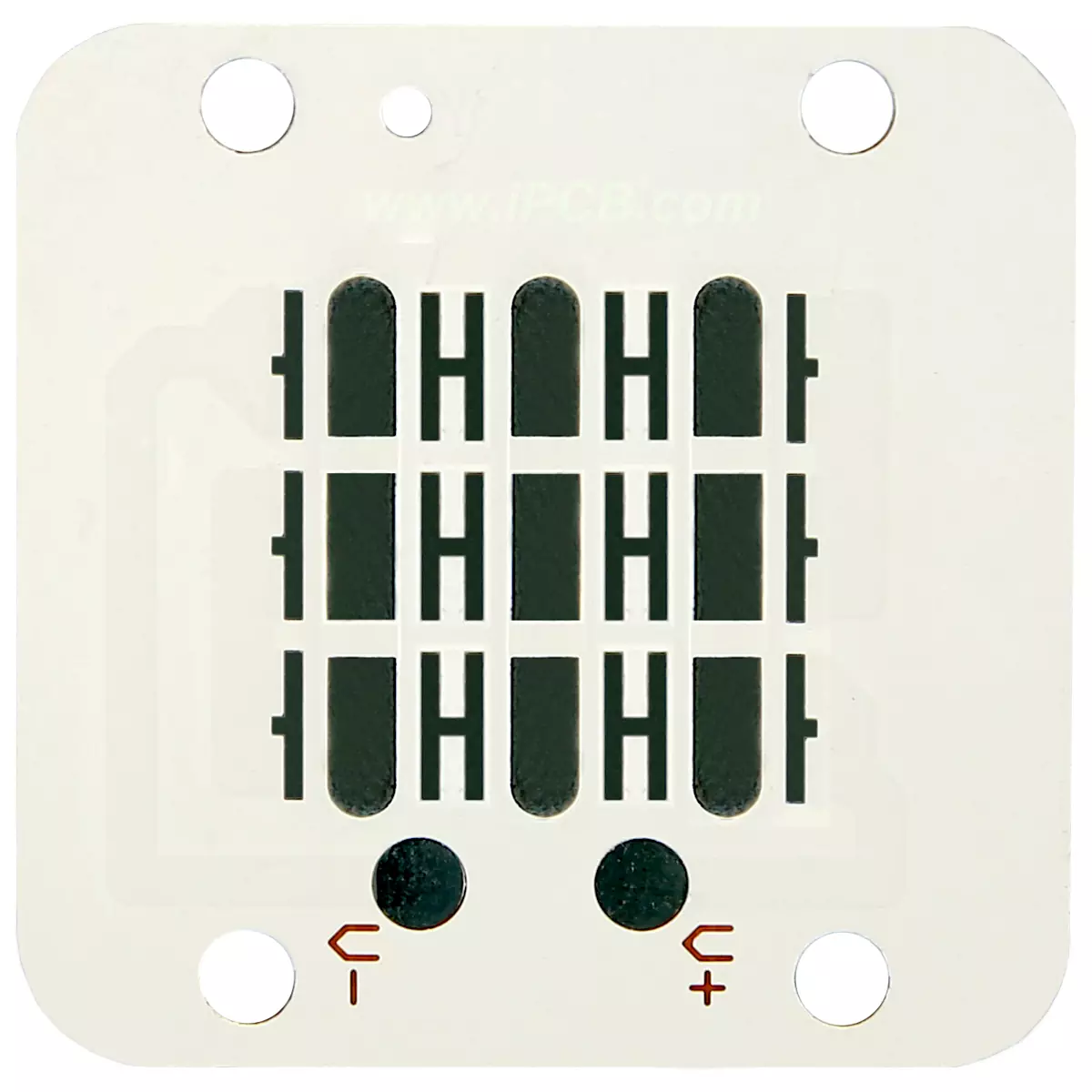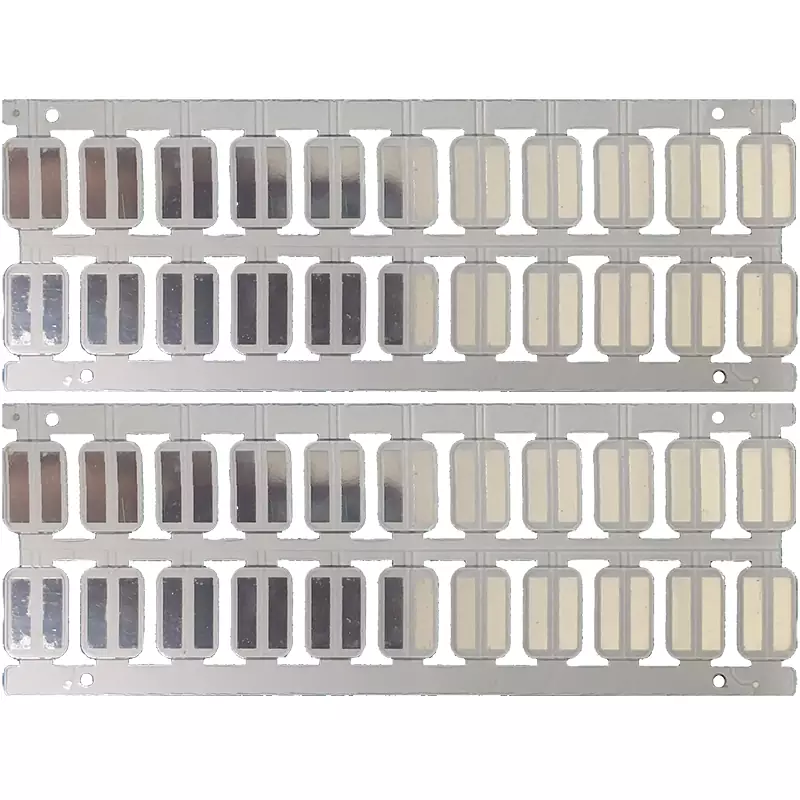

Product: Aluminum PCB
Material: aluminum or copper
Layer: 1-2L
Color: White
Finished thickness: 2.0mm
Copper thickness: 3oz
Surface treatment: Lead Free HASL
Minimum line width: 10mil
Minimum spacing: 10mil
Thermal conductivity: 400W/mK
Application: High power LED emitter
What is Thermal Separation PCB?
Thermal Separation refers to a heat and circuit separation process in copper substrate processing. The circuit and thermal layer parts of a Thermal Separation PCB are located on different circuit layers, with the thermal layer part directly in contact with the heat dissipation part of the lamp beads, achieving the best heat dissipation and thermal conductivity effect. The highest thermal conductivity of ordinary aluminum PCB/copper PCB is 1W/M.K, 2W/M.K, 3W/M.K, 5W/M.K, single digits, suitable for low-power LEDs in some household appliances. The thermal conductivity of the thermoelectric separation PCB is 400W/M.K, which overcomes the shortcomings of insufficient thermal conductivity and heat dissipation of existing copper substrates. This process directly conducts the heat generated by electronic components through the heat dissipation area, greatly improving the heat dissipation effect.
Advantages of Thermal Separation PCB
1. Adopting a thermoelectric separation structure, it has zero thermal resistance in contact with the lamp bead, greatly reducing the decay of the lamp bead and extending its lifespan.
2. Copper substrate is selected, with high density, strong thermal bearing capacity of the substrate itself, and good thermal conductivity and heat dissipation.
3. Copper substrate has high density and high heat carrying capacity, and the product is smaller under the same power condition.
4. Suitable for matching single high-power lamp beads, especially COB packaging, to achieve better lighting effects.
5. Various surface treatments (OSP, tin spraying, gold plating, gold plating, silver plating, etc.) can be carried out according to different needs, ensuring the reliability of the surface treatment layer.
6. Different structures (copper convex blocks, copper concave blocks, parallel thermal and circuit layers) can be made according to the design needs of the lighting fixtures.
Why is there such a large power difference between Thermal Separation PCB and ordinary aluminum PCB and copper PCB?
The thermoelectric separation PCB uses lamp beads directly connected to a copper substrate.
Ordinary aluminum PCB and copper PCB: The heat dissipation part of the lamp bead is connected to the aluminum PCB and copper PCB through insulating thermal conductive materials. The quality of the thermal conductive material determines the size of the thermal conductivity, which cannot fully utilize the heat dissipation advantages of the substrate.
The production of thermoelectric separation PCB is more complex than aluminum PCB and copper PCB, and like the production of FPC and multilayer circuit board, it requires many additional processes. Ordinary PCB and copper PCB production are simple, just like ordinary FR-4 single panel production.
For example, for an LED bead with a driving power of 13W, when the module radiation power and thermal power are roughly the same, the chip junction temperature corresponding to the Thermal Separation PCB and the ordinary copper substrate are 49.72 and 73.14 ℃, respectively, and the corresponding module thermal resistance is 2.21 and 4.37 ℃/W, respectively. This means that the Thermal Separation PCB has more advantages in high-power LED heat dissipation management compared to ordinary copper substrates.
The manufacturing process of Thermal Separation PCB includes applying protective tape on one side of the copper substrate, forming anti etching ink through circuit board technology, exposure, development, etching and other processes to create protrusions in the heat dissipation area. The height of the protrusions is equal to the thickness of the insulation layer and circuit layer. A layer of copper plating is electroplated on the aluminum surface through zinc immersion and electroplating copper plating technology, and the circuit layer (copper foil) and insulation layer (non flowing adhesive semi cured sheet) are stacked together. Windows are opened in the heat dissipation area of the circuit layer and insulation layer, which can be opened by mold punching or CNC molding processing. The heat dissipation layer (copper plated aluminum substrate), circuit layer (copper foil), and insulation layer (non flowing adhesive epoxy semi cured sheet) are pressed together by hot pressing according to the circuit board. Once the circuit layer circuit is produced through the processing flow, the Thermal Separation PCB can be manufactured.
Thermal Separation PCB can separate the thermal layer from the circuit layer, allowing the heat generated by the components to be directly conducted out through the heat dissipation area, greatly improving the thermal conductivity efficiency and thus extending the product's service life.
Product: Aluminum PCB
Material: aluminum or copper
Layer: 1-2L
Color: White
Finished thickness: 2.0mm
Copper thickness: 3oz
Surface treatment: Lead Free HASL
Minimum line width: 10mil
Minimum spacing: 10mil
Thermal conductivity: 400W/mK
Application: High power LED emitter
iPCB Circuit provides support for PCB design, PCB technology, and PCBA assembly. You can request technical consultation or quotation for PCB and PCBA here, please contact email: sales@ipcb.com
We will respond very quickly.